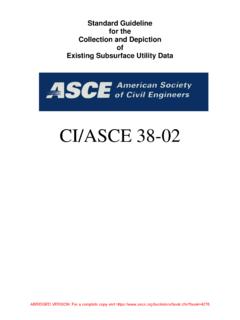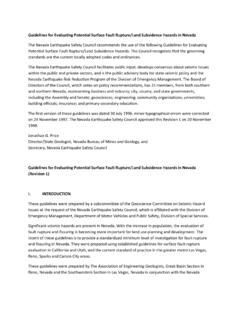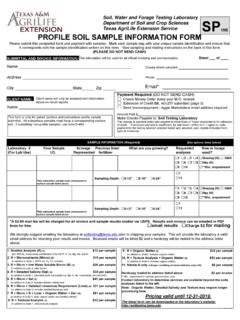Transcription of Water Intake Structures for Surface and Subsurface Waters
1 UNESCO EOLSSSAMPLE CHAPTERSWATER STORAGE, TRANSPORT, AND DISTRIBUTION Water Intake Structures for Surface and Subsurface Waters - Shuji Takasu and Toshio Hirose Encyclopedia of Life Support Systems (EOLSS) Water Intake Structures FOR Surface AND Subsurface Waters Shuji Takasu Hydraulic Engineering Research Group, Public Works Research Institute, Independent Administrative Institution, Japan Toshio Hirose Former Vice-Minister, Ministry of Construction, Japan, and Vice-President, Japan Commission on Large Dams, Tokyo, Japan Keywords: Surface Intake , Subsurface Intake , multi-level Intake , selective withdrawal facility, Water quality control curtain, circulator, aeration facility, eutrophication, suspended solids, cold Water , warm Water , Intake tower.
2 Contents 1. Introduction 2. Types 3. Water Quality Control 4. The Reservoir Environment 5. Composition of the Intake Work 6. Operation and Maintenance of the Intake Glossary Bibliography Biographical Sketches Summary In this chapter, the withdrawal of Water from a reservoir is described and the relations between the withdrawal, the reservoir environment, and the function of the Intake work aee examined. Storage of running Water affects both the Water quality of the reservoir and the flow rate and Water quality of the downstream river channel. 1. Introduction A reservoir is constructed in order to store Water while it is required.
3 Stored Water is withdrawn from the reservoir in order to utilize the energy of the Water or Water itself. In this chapter, the withdrawal of Water from a reservoir is described and the relation between the withdrawal, the reservoir environment, and the function of the Intake structure is described. Most Water stored in reservoirs is utilized for irrigation, and a smaller volume is supplied to urban Water supply systems. Hydraulic power generation utilizes the energy of the stored Water without consuming it. The running Water may be stored for future use and for pumped storage generation, smoothing the seasonal variation of flow rate in UNESCO EOLSSSAMPLE CHAPTERSWATER STORAGE, TRANSPORT, AND DISTRIBUTION Water Intake Structures for Surface and Subsurface Waters - Shuji Takasu and Toshio Hirose Encyclopedia of Life Support Systems (EOLSS) order to improve the annual utilization efficiency, even at hydraulic power generation reservoirs.
4 Water may be supplied to the downstream river, using Water stored in the reservoir, in order to provide ecological benefits during dry periods. There is a difference between withdrawal from a reservoir and direct withdrawal from a river or from underground. Storage of running Water affects the Water quality of reservoirs as well as the flow rate and quality of the downstream river channel. When Water is directly taken from a river, the Water retention phenomenon does not occur, because it fundamentally does not accumulate. Since environmental problems, land subsidence, etc.
5 , may arise, when balance between supply and demand of groundwater is not maintained, it is necessary to control withdrawal of groundwater. This slows the flow of groundwater, and it is necessary to consider the effect on a very long time scale. Water from a reservoir may be discharged direct to the river downstream of the dam, or directly transported through a Water channel and/or tunnel to the place where it is utilized. The required Water quality is dependent on the proposed Water -use, drinking Water , industrial Water , irrigation, environmental enhancement.
6 Intake works must be planned with regard to reducing the negative effect on the environment in the reservoir. Spillway and outlet works for flood control must be incorporated, in order to allow discharge from the reservoir during periods of flood or prolonged high inflow. Nitrogen and oxygen become supersaturated by aeration caused by discharge from these outlet facilities, and fish survival may be threatened in the downstream river. Nitrogen is dangerous to fish as a supersaturated gas, as it is absorbed in the blood, and can form intravenous bubbles.
7 In addition, a sediment flushing facility and a facility for drawdown must be included within the structure of the dam, in order to ensure their appropriate function and safety. Though the use of these facilities is limited, their operating method must be considered, because it may cause significant impact to the downstream ecosystem. 2. Types In temperate and subtropical regions, low-temperature river Water which flows in autumn and winter is stored in the bottom layer of the reservoir. Solar radiation to the reservoir Surface is intensified in the early spring, and the Surface Water is warmed.
8 The temperature of the Water stored in the reservoir s upper layer is further increased by inflow, because its temperature also rises at this time. Thermal stratification, stabilizing the upper and lower layers, therefore occurs in summertime. The Water quality, dissolved oxygen and nutrients, and distribution of suspended matter, depends on this stratification. In cold climates, however, the Surface Water is cooled, and a different form of thermal UNESCO EOLSSSAMPLE CHAPTERSWATER STORAGE, TRANSPORT, AND DISTRIBUTION Water Intake Structures for Surface and Subsurface Waters - Shuji Takasu and Toshio Hirose Encyclopedia of Life Support Systems (EOLSS) stratification develops, in which the bottom layer is at a higher temperature.
9 This occurs when the Surface layer is 4 oC. or less. Mixing of the top and bottom layer is inhibited when a thermocline is created with a strong density difference between the top and bottom, and the oxygen supply to the bottom layer may become inadequate. Intake Structures are generally designed and operated to suppress the development of a thermocline. The flow in the reservoir is fundamentally a density current, because density stratification is formed. Though the density current mainly originates from thermal stratification, it is necessary to take account of the variation in density as a consequence of turbidity, when there inflow of turbid, high-density Water at times of flood.
10 The Structures described below are being tried in order to ensure provision of Water with a quality appropriate to the intended use. 1) Surface Intake A Surface Intake is used in order to take Water from the reservoir Surface when is comparatively clear. Obviously, the withdrawal must follow the fluctuations of the reservoir level. It is necessary to prevent contamination of the lower layers in order to efficiently take the Surface Water . Hydraulic examination is conducted to determine the approach velocity distribution and withdrawal Water depth. 2) Subsurface Intake (Submerged Intake ) Regardless of the reservoir Water level, a Subsurface Intake takes Water from a low level in the reservoir.













